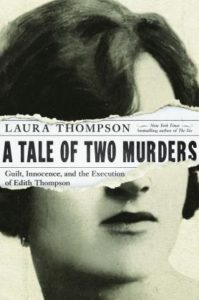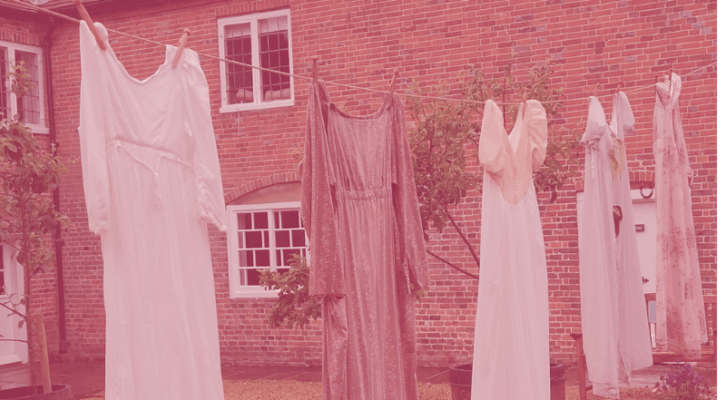From A Tale of Two Murders: Guilt, Innocence, and the Execution of Edith Thompson
__________________________________
There was a double hanging at Holloway jail on the morning of 3 February 1903. As Edith Graydon was skip-hop-skipping her way to school, traveling without foreknowledge through the neat, self-respecting, know-your-place streets of suburban east London, two women were waiting in their death cells to experience the last seconds of life. They had conspired together in their crimes, and they died side by side, in the same jolting moments of the morning. These were the first of the five hangings that would take place at Holloway, which had become an exclusively female prison in 1902.
Some murderers permit empathy, but Annie Walters and Amelia Sach do not: they were baby farmers, taking in unwanted children (of whom there were many) for an ‘adoption fee’, then disposing of them with chlorodyne. Such crimes were impossible to forgive. Despite the usual mitigating circumstance of poverty there was never any chance of a reprieve for Walters and Sach.
Anyway there was only muted opposition to the death penalty in 1903. Abolitionists had been making their case since the 1830s, but they did not really hit their stride until the 1920s, and even then the authorities remained adamantine. As Sir John Anderson, Permanent Under-Secretary of State in the Home Department, said in 1923 to the prison reformer, Margery Fry, those who opposed the death penalty were all too often ‘sentimentalists’.
So the public face of authority was obdurate, even as the stirrings of national queasiness were beginning to be felt (these came in waves, and were not felt by everybody). Throughout the eighteenth and early nineteenth centuries, hangings had been the rampageous stuff of fatalistic folklore, part of the terrible theatre of daily life. From 1868 they took place in private, and perversely this made their reality less tenable. One knew where one was, at least, with the condemned who drank their nerves down on the ride from Newgate to Tyburn, and made bravura speeches to the open skies. The spectacle was appalling, but it was honest. Behind closed doors everything was contained within brick and stone, institutional buff and grey. It was measured and mechanistic, catalogued in paperwork by civil servants who blotted their words with passionless care. But it was still what it was. The form signed by the sheriff, the under sheriff, the prison governor, to the effect that they had witnessed the event—how stately it looked, with its black flourishes and curlicues—but the question remained: what had they witnessed? The inquest upon the executed person, conducted almost immediately and with such conscientiousness, with evidence and a jury, as if enclosing the event within the jaws of legal righteousness—but still the words had to be written, in crabbed fountain pen, that the said person ‘died from fractured dislocation of the cervical vertebrae’.
The bureaucracy was absolute, however; it could not be faulted or gainsaid. ‘Gentlemen, As directed in Standing Order no.459, I have the honour to submit the annexed Record of the execution of the above-named Prisoner’: so ran the printed words on a form sent to the Home Office from the prison governor. When opened out, the form requested ‘Particulars of the Execution’. Rather like an examination paper in human biology, it asked for an ‘Approximate statement of the character and amount of destruction to the soft and bony structures of the neck.’ A typical reply recorded ‘Bruising of neck from rope. Fracture of odontoid process and right half of arch of Axis.’ Then came a request for ‘The length of the drop as determined before the execution,’ and a subsequent request for ‘The length of the drop, as measured after the execution, from the level of the floor of the scaffold to the heels of the suspended culprit.’ The answers to these two questions differed by a neatly inked two or three inches, nothing more.
There was also a Memorandum of Instructions for carrying out an Execution, drawn up in 1891 and amended three times, in reaction to events that did not quite go to plan. Again the attention to detail was irreproachable. The ‘apparatus’, meaning the drop, had to be tested a week before the hanging, first without any weight attached, then with a sandbag. ‘As the gutta percha [rubber] round the noose end of the execution rope hardens in cold weather,’ the memorandum continued, for all the world as if advising on the best outcome for a recipe, ‘care should be taken to have it warmed and manipulated immediately before the bag is tested.’ On the day before the hanging the apparatus was tested again, and the sandbag left in place overnight to ‘take the stretch out of the rope’. Then the execution shed, with its makeshift aspect and its array of basic tools, was locked. The key was kept by the prison governor.
As with the appointment of hangmen who knew their job, and killed with the intention to inflict a minimum of extraneous suffering—men such as the Pierrepoints, whose family trade this was—so every trouble was taken to make judicial execution a series of coolly predict able processes. Some of these could not help but be dramatic—the piece of black cloth floating on the judge’s wig; the chaplain reciting ‘I am the Resurrection and the life’ on the way to the scaffold—but the rolling gravitas of ritual was, after all, what the supreme penalty required. And these rituals had God on their side, albeit a Low Church kind of God. What was going on was functional, formulaic, a regret table necessity. Death for those found guilty of a capital crime was ‘the due course of the law’: a phrase so deliberately impersonal as to imply that ‘the law’ had its own independent volition, and was not something created by mere people.
***
More accurately it was created by men. ‘Gentlemen …’ Not until 1919 did a sole female legislator enter the House of Commons, and in 1922 two women were called to the English Bar—’I confess that at first I viewed the new step with alarm,’ the distinguished barrister Travers Humphreys (born 1867) would later write. He came round eventually, although he worried that women spoke too quietly in court, and wished that they would stay away from criminal law: ‘There must be so much that is repulsive to a young woman in criminal practice.’
Women, with their soft voices and soft bodies, were not equal with men at this time. They were so far from being equal that they could not even vote until 1918, and then only if they were aged thirty or more. Yet they were equal in this regard: they could be hanged.
At the very end of 1922—a time when the question of female execution was dominant in the news, and becoming almost dangerously emotive—a document was drawn up by a senior Home Office civil servant, Sir Emley Blackwell, and sent to Sir John Anderson. Its intention, as usual with this issue, was to codify and calm. It listed the women who had been convicted of murder in England and Wales since 1890, excluding infanticide (the specific crime of a woman killing her baby within a year of birth had recently ceased to be a capital offence: there was a dim understanding of the wretchedness that might lie behind it). Twenty-three names were typed on the document, together with a brief description of what they had done, and whether or not they had been executed for it.
Nine of the women had been hanged. Six of these had murdered other people’s children, a seventh was a sadistic mother. Condemnation was therefore an easy business. Of the remaining two, Mary Ann Ansell had poisoned her mentally incapacitated sister for £11 in life insurance—unarguably cruel again—while Emily Swann was executed, alongside her lover in another double hanging, for the murder of her husband.
Therefore fourteen women were ‘respited’, as the legal term had it. One was deemed insane and another, aged seventy-two, had dementia. Two were reprieved on grounds of drunkenness. Mercy was recommended and given to one who cut the throat of her husband’s lover; this was a crime of passion, which implied lack of premeditation. The same reasoning was applied to two women who knifed their common-law husbands. And two child-killers were reprieved, thanks to a twist of circumstance that surely struck even the sober men of law: they were pregnant.
So might a kind of logic be discerned? The authorities executed women who had become ‘unwomanly’; who had behaved in a manner so unnatural that it rendered them equal indeed with men, and obliterated any special privilege of gender. Throughout this thirty-two-year period a total of 457 men were hanged in England and Wales (plus sixteen in Scotland), which shows the rarity of the female murderer, and the straightforward shock value accruing to crimes that subverted the feminine ideal. With Mary Ann Ansell the home secretary actually spelled this out, saying that the law must take its course because ‘sex alone should make no difference in such a case’.
Nevertheless there were inconsistencies. Two servants who suffocated an old woman in the course of a robbery were reprieved in 1902. As for Fanny Gilligan, another woman who murdered her lover—was it passion or premeditation that caused her to coat the man in paraffin and set him alight? Yet she received the benefit of legal doubt. The home secretary respited her in 1911, ‘with particular regard to her sex’. Perhaps this was to do with the god-awful hopelessness of some of these women, the low class of life that they inhabited; as with those who murdered when drunk, reprieve became a function of patronage (foolish creatures, they know no better). If, however, the woman was thought to have dis played agency, rather than passivity, it usually went badly for her.
Given this, however: was it an easy thing to judge? Particularly in the cases of dual enterprise, in which women were accused alongside a man and the challenge was how to apportion blame. To take a familiar example: who is more culpable, Macbeth or his wife? Are they in fact equally guilty, under what would become the legal doctrine of Common Purpose? Possibly, but here is a slightly different question: what would a court have decided, had it tried them both for the murder of Duncan? The evidence of joint action was slim. A verdict would almost certainly have come down to demeanour—what the courtroom made of them—whether Lady Macbeth looked more like her husband’s dominatrix or his victim. In the real world of 1910, Ethel le Neve was acquitted of being an accessory to the murder of Cora Crippen, although she had fled the country along with Cora’s husband and worn the dead woman’s jewels. Dr Crippen took all the blame, and it may be rightly so, but Le Neve’s appearance—pale, doe-eyed, as if in need of smelling salts—would have assuredly helped her evade a charge of full conspiracy.
In two other cases of dual enterprise—in 1900 and 1918—the woman was regarded as the more guilty party. One was hanged, the other saved only by pregnancy. Significantly these were child-murders. Otherwise it was all rather wayward, but then the law is never quite as consistent as it likes to claim; and what truly goes on between two people, high on amorousness and excitation, is well-nigh impossible to know. In 1903 Emily Swann was tried for murder after her lover, John Gallagher, killed her husband with a poker. Swann was considered equally guilty. She had been present at the murder and was said to have shouted encouragement. As the judge put it: ‘one does not commit murder only with one’s hands. If one person instigates another to commit murder, and that other person does it, the instigator is also guilty of murder.’
This was the law. ‘It was,’ wrote Sir Emley Blackwell, ‘laid down by Serjeant Foster in his “Crown Cases” as long ago as 1776.’ Yet Mary Stone—also convicted in 1903—was respited after the murder of her lover’s wife. There was deemed to be doubt as to her share in the crime, but the same could have been said of Swann. What may have counted most strongly against Emily Swann was her age: she was some twelve years older than Gallagher, and therefore assumed to be the dominant partner. Conversely—and contentiously—in September 1922 the young Elsie Yeldham had lured an ex-boyfriend to a remote place in Epping Forest, where her husband-to-be killed and robbed him. This sounded very much like malice aforethought; but, as Blackwell commented, ‘the judge thought the woman acted under influence of the man’. This could only have been an opinion, as the trial was a shambles. Mrs Yeldham’s reprieve was not quite the Scottish verdict of ‘not proven’; she had, after all, been convicted. It was more like ‘not quite proven enough for the state to hang you for it’.
This, at any rate, was the best guess of Mrs Yeldham’s judge, Mr Justice Shearman. The home secretary, Edward Shortt, a lawyer himself and a man of some compassion, concurred with the legal opinion. ‘On this and in view of her sex, it was decided to commute.’
***
It was the state that hanged the criminal, that smooth bureaucratic entity with its painstaking observances, its measuring tape wielded against the rope. The job of the state was to preserve the moral workings of society, and this meant judicial hanging.
The trouble was that it was not the state, in the end, that did the deed. Dry and calm as the workings of the execution were supposed to be, there was nonetheless the physicality of it … One person had to take hold of another, handle them, march them, look them in the eye. These were the moments when the grip of the law became slippery and parlous. The coroner would ask at the inquest if the sentence of death had been properly carried out: ‘Was there any hitch at all?’ The answer would come: ‘None of any kind. Death was instantaneous and there was no delay in carrying out the execution.’ The grip was resumed, all was well again. And yet. There was still the implicit sense of what lay within those words. And when the executed person was a woman, soft of voice and body, the giver of life and the fireside consoler of men—men who now had to steady her, urge her to her feet, feel her resistance, feel the flesh of her arm still warm and working, touch her in a way that would then have implied erotic intent …
By stripping the convicted woman of her forename and title she was rendered almost sexless. She was her crime, and the hangman understood as much.The law knew, perfectly well, that there was no problem about any of this. By stripping the convicted woman of her forename and title she was rendered almost sexless. She was her crime, and the hangman understood as much. Henry Pierrepoint wrote comfortably of Walters and Sach that they were ‘baby farmers of the worst kind and they were both repulsive in type. One was two pounds less than the other and there was a difference of two inches in the drop which we allowed. One (Sachs) had a long thin neck and the other (Walters) a short neck, points which I was bound to observe in the arrangement of the rope.’ So, a job well done.
The document sent to Sir John Anderson in 1922 was intended, although it did not say so, to justify the execution of women, to bolster official courage. That is probably why the list began in 1890 rather than the more obvious 1900: the total was thus almost doubled, from five women to nine. The comments—’Gilligan might have been exed & very nearly was!’—were also designed to show the essential firmness of the law. At the same time the number of reprieves was increasing steadily. The final phase of the death penalty can be said to fall between the last public execution in 1868 and the last executions of all: in 1955 for a woman and in 1964 for men. During that period the reprieve rate for women rose from roughly 25 per cent to 90 per cent, about twice that of men. Until the Homicide Act of 1957 narrowed the definition of what constituted a capital crime, every person convicted of murder had to be given a death sentence, even though reasons not to carry these out—such as diminished responsibility—were becoming more common. In early twentieth-century crime fiction the implication is that almost any killer will be hanged—therein lies much of the moral force of Golden Age detective novels—but in truth this was not the case, especially with regard to women. In late 1922, when the Home Office list was being typed up, two prisoners were under sentence of death at the jail—one of whom, Daisy Wright, had thrown her daughter off Tower Bridge—but at that point no woman had been executed for more than fifteen years. Indeed it looked quite likely that Rhoda Willis, condemned for baby farming in 1907, would become the last to be hanged.
Without admitting as much, the authorities had allowed loopholes to replace nooses. They feared ‘sentimental’ public reaction—there had even been a petition to save Willis—and then there was this other aspect, the illogical sense that it was somehow worse to hang a woman than a man.
Because it was illogical, and because it did implicitly dictate policy, at the same time it had to be explicitly fought. Therefore accompanying the typed list of twenty-three names, the executed and the respited, was a long memorandum. It argued that the second woman under sentence of death at Holloway should be hanged.
The only possible argument that could be urged for the reprieve of this woman may be summed up in the expression ‘We don’t hang women nowadays: This is an entirely fallacious idea which is due to the fact that for fifteen years there has only been one case in which the execution of a woman was or could have been seriously considered. That was the case of Fanny Gilligan …
As regards the execution of women generally, the trend of recent legislation has been all in favour of equality between the sexes … On general and constitutional grounds I doubt myself whether it is open to the home secretary to advise the King to respite the capital sentence in the case of a woman merely on the ground of her sex. In this case it would be absolutely impossible, to my mind, to give any other grounds.
If the capital sentence in the case of women is to be abolished, this must be by legislation and not by the exercise of the Prerogative of mercy.
***
As much emotion as possible had been sucked from the death penalty. As much dignity as the system deemed appropriate was accorded to the prisoner. In turn it was hoped that the prisoner would behave with dignity: that the most difficult process of all would pass off without undue distress to those concerned. Everything was supposed to be upright and steely and signed off with a handshake.
Albert Pierrepoint, who executed more than 400 people, believed that a woman was as capable of that forbearance as a man. The only person whom he described kicking up rough was a German spy, who fought like a bear with those who sought to put him to death. ‘It was unfortunate. He was not an Englishman.’ By contrast Pierrepoint recalled ‘young lads and girls, working men, grandmothers. I have been amazed to see the courage with which they take that walk into the unknown.’
In fact at least one other man behaved inappropriately at the last: Patrick Mahon, hanged in 1924, tried to jump off the trapdoor before it opened. Nevertheless, if what we are told is true, a surprising number of the condemned did conduct themselves with ramrod restraint at the end. Pride, straightforward will, disdain for the only-obeying-orders performances of those around them, may have got them through. Or they may have felt that there was no point in giving way. Easier for them if they held on. Easier for everybody. Indeed there is a sense, in reports of these stiff, stalwart, spirit-swallowing endings, of the condemned prisoner behaving well out of a kind of terrible courtesy. It is an echo of the aristocratic pardon given to the axeman, and it is consoling, even to us, who no longer have to bear the collective guilt of a death penalty enacted in our name. Easier, even for us, to read of Ruth Ellis—the last woman to be hanged—smiling at Pierrepoint on the gallows.
‘You might make it a double, old boy,’ is said to have been the last request of Neville Heath, a sex-murderer who nonetheless knew how to behave. This was the gallant way, the gentlemanly way, which incidentally might also be assumed by women. Emily Swann relied on brandy to pull herself together before she joined her lover on the drop at Armley jail. ‘Good morning, John,’ she said, civilly, as she approached him. ‘Good morning, love,’ was the reply.
Eleven months earlier, at the double hanging at Holloway, Annie Walters is reported to have spoken with a similar bravura: ‘Goodbye Sach,’ she called, as one waving a friend on to an omnibus. Walters, a woman in her fifties, left her life stoically. Or so we are told; at any rate her behaviour was contrasted with that of the other prisoner, some twenty years her junior, who was not brave. She may have intended to be, but Amelia Sach was unable to control her emotions. The reality of death hit her differently from Walters: it hit her completely.
And why the hell should I make it easy for them, Sach may have thought; although more likely she thought nothing at all, she simply felt. Which meant inhabiting a state of mind so impossible that the only way out was oblivion. The end too terrible to assimilate was, at least, the end to the suffering that it bred.
By 9.01am, or so the innocent living would have been told, it was all over. Skip-hop-skip, went Edith Graydon on her way to school.
__________________________________
From A Tale of Two Murders: Guilt, Innocence, and the Execution of Edith Thompson, by Laura Thompson, courtesy Pegasus Books. Copyright © 2018, Laura Thompson.


















